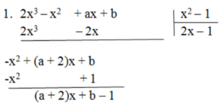Tìm a, b để đa thức A ( x ) = 2 x 3 – x 2 + a x + b chia hết cho đa thức B ( x ) = x 2 – 1
Hãy nhập câu hỏi của bạn vào đây, nếu là tài khoản VIP, bạn sẽ được ưu tiên trả lời.



b: \(=\dfrac{2x^4-2x^3-2x^2-3x^3+3x^2+3x+x^2-x-1}{x^2-x-1}\)
\(=2x^2-3x+1\)

a: =>2x^3-4x^2-3x^2+6x+4x-8+a+8 chia hết cho x-2
=>a+8=0
=>a=-8
b: =>2x^3+x^2-x^2-0,5x-0,5x+0,25+m-0,25 chia hết cho 2x+1
=>m-0,25=0
=>m=0,25

a: \(\Leftrightarrow2x^4-2x^3+2x^2+3x^3-3x^2+3x-2x^2+2x+2+a-2⋮x^2-x+1\)
=>a=2

a) Áp dụng định lý Bézout ( Bê-du ) , dư của \(f\left(x\right)=x^3+x^2-x+a\)cho x + 2 = x - (-2) là \(f\left(-2\right)\)
Để f(x) chia hết cho x + 2 thì f(-2)=0
\(\Rightarrow\left(-2\right)^3+\left(-2\right)^2-\left(-2\right)+a=0\)
\(-8+4+2+a=0\)
\(a-2=0\)
\(a=2\)
Vậy ...
c) \(\frac{n^3+n^2-n+5}{n+2}=\frac{n^3+2n^2-n^2-2n+n+2+3}{n+2}\)nguyên để \(n^3+n^2-n+5⋮n+2\)
\(\Rightarrow\frac{n^2\left(n+2\right)-n\left(n+2\right)+\left(n+2\right)+3}{n+2}\in Z\)
\(\Rightarrow n^2-n+1+\frac{3}{n+2}\in Z\)
\(n^2,n,1\in Z\Rightarrow\frac{3}{n+2}\in Z\)
\(\Rightarrow n+2\inƯ\left(3\right)=\left\{-3;-1;1;3\right\}\)
\(\Rightarrow n\in\left\{-5;-3;-1;1\right\}\)
Vậy ...

a: \(\Leftrightarrow x^3+2x^2-3x^2-6x+5x+10+a-10⋮x+2\)
=>a-10=0
=>a=10
b: \(\Leftrightarrow x^3+x^2+x+\left(a-1\right)x^2+\left(a-1\right)x+a-1+\left(2-a\right)x+b-a+1⋮x^2+x+1\)
=>2-a=0 và b-a+1=0
=>a=2; b=a-1=2-1=1

Đa thức \(x^2-1\)có nghiệm \(\Leftrightarrow x^2-1=0\)
\(\Leftrightarrow x^2=1\Leftrightarrow x=\pm1\)
-1 và 1 là hai nghiệm của đa thức \(x^2-1\)
Để đa thức \(2x^3-x^2+ax+b\)chia hết cho đa thức \(x^2-1\)thì -1 và 1 cũng là hai nghiệm của đa thức \(2x^3-x^2+ax+b\)
Nếu x = -1 thì \(-2-1-a+b=0\Leftrightarrow a-b=-3\)(1)
Nếu x = 1 thì \(2-1+a+b=0\Leftrightarrow a+b=-1\)(2)
Từ (1) và (2) suy ra \(\hept{\begin{cases}a=\frac{-3-1}{2}=-2\\b=\frac{-1+3}{2}=1\end{cases}}\)
Vậy a = -2, b = 1

a) \(A\left(x\right)=2x^3-x^2-x+1\)
\(=\left(2x^3-4x^2\right)+\left(3x^2-6x\right)+\left(5x-10\right)+11\)
\(=\left(x-2\right).\left(2x^2+3x+5\right)+11\)
Vậy \(A\left(x\right):B\left(x\right)=2x^2+3x+5\) dư \(11\)
b) Để \(A\left(x\right)⋮B\left(x\right)\) thì \(11⋮B\left(x\right)\)
\(\Rightarrow x-2\inƯ\left(11\right)=\left\{\pm1;\pm11\right\}\)
\(\Rightarrow x\inơ\left\{13;3;2;-9\right\}\)

a: \(=\dfrac{2x^4-2x^3-2x^2-3x^3+3x^2+3x+x^2-x-1}{x^2-x-1}\)
\(=2x^2-3x+1\)
